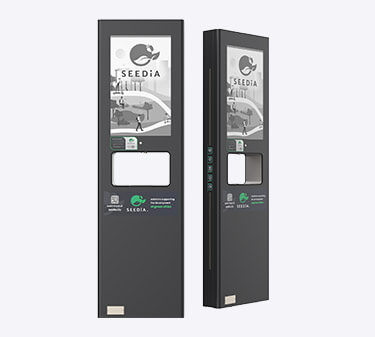Providing information to local communities can be challenging. Solar infokiosks with dispensing capabilities offer a solution by enabling remote and automated content management through cloud communication. Incity.io CMS is a tool that allows you to work in advertising and information mode, so that the city can provide public information and monetize ads by presenting content on display. In addition, information about interactions, smog levels, CO2 emission reductions or humidity is displayed on the screen and in the mobile application. Bring more information



The most advanced model. In addition to disinfection, it also provides the functions of a remote managed audio and e-paper display capabilities, which also educate and communicate through video and audio that can be remotely accessed and changed.
As cities become more interconnected, the need for efficient and sustainable information delivery systems has grown. Smart solar infokiosks meet this need by combining advanced technology with eco-friendly design. These kiosks are powered by solar energy, reducing the need for external power sources and minimizing carbon footprints. They offer a range of features, from real-time information displays to USB charging ports, making them a versatile and valuable addition to any urban area.
A smart solar infokiosk is a multifunctional, solar-powered station designed to provide information, advertising, and public services in urban spaces. Equipped with solar panels, these kiosks harness solar energy to power a variety of features, including e-paper displays, Wi-Fi hotspots, and USB charging ports. They can be remotely managed through platforms like Incity.io, allowing municipalities to update content and monitor kiosk performance in real-time.
The backbone of a smart solar infokiosk is its solar power system. Solar panels installed on the kiosk capture solar energy, converting it into electricity to power the kiosk’s features. This energy independence makes the infokiosk an ideal solution for cities looking to reduce their reliance on grid power and promote renewable energy. The use of solar power also helps decrease CO2 emissions, aligning with global sustainability goals.
One of the most practical features of a smart solar infokiosk is its charging capabilities. With built-in USB charging ports and wireless chargers, these kiosks provide a convenient way for people to charge their devices while on the go. This amenity is especially valuable in public spaces where access to power outlets may be limited, ensuring that residents and visitors can stay connected at all times.
In today’s digital age, access to the internet is a necessity. Smart solar infokiosks serve as Wi-Fi hotspots, offering free internet access to the public. This feature not only enhances the functionality of public spaces but also promotes digital inclusion by providing internet access to those who may not have it at home. The integration of Wi-Fi into these kiosks turns parks, squares, and other outdoor areas into connected, smart spaces.
A key feature of the smart solar infokiosk is its eink display, a large, remotely operated screen that can provide real-time information. Whether it’s displaying public announcements, advertisements, or real-time data like air quality and humidity levels, the e-paper display is a flexible tool for cities to communicate with their residents. This technology is energy-efficient and can be easily updated via cloud-based management systems like Incity.io.
Our e-paper wayfinding kiosks are designed to provide easy access to information and services, enhancing the customer experience in public spaces. Our kiosks can display range of information, maps and directions, helping users navigate complex environments. The e-ink technology ensures that the information is clear and readable, even in bright sunlight, making them ideal for both indoor and outdoor use. Our kiosks are equipped with specialized hardware and software, allowing customers to quickly find their way and access relevant information. By integrating these digital kiosks, we are improving the efficiency of wayfinding in various settings.
Smart solar infokiosks are equipped with various environmental sensors that monitor air quality, humidity, noise levels, and more. This data is not only displayed on the kiosk’s screen but can also be accessed via mobile applications, providing valuable insights into the local environment. These sensors help cities better manage urban spaces and make informed decisions about public health and safety.
One of the standout features of smart solar infokiosks is their ability to be managed remotely. Through platforms like Incity.io, city officials can update kiosk content, monitor environmental data, and even control features like audio playback. This remote management capability allows for greater flexibility and efficiency in maintaining the kiosks, ensuring they always provide relevant and up-to-date information.
A significant advantage of smart solar infokiosks is their ability to be customized to fit the aesthetic of any urban space. Cities can personalize the kiosk’s appearance, including color and design, to ensure it harmonizes with the surrounding environment. This customization makes the kiosks not only functional but also an attractive element of public spaces, enhancing both the visual appeal and functionality of urban areas.
Smart solar infokiosks have been successfully implemented in cities around the world, demonstrating their versatility and effectiveness. From European capitals to small towns, these kiosks are proving to be a valuable tool for urban communication and public service. Each case study highlights how cities have used these kiosks to enhance public spaces, provide important information, and promote sustainability.
Investing in smart solar infokiosks is a step towards a more sustainable, efficient, and connected city. These kiosks provide numerous benefits, from reducing energy consumption to enhancing public engagement. As urban areas continue to grow and evolve, the need for smart, sustainable solutions like solar infokiosks will only increase. By incorporating these devices into public spaces, cities can improve communication, promote digital inclusion, and support their sustainability goals.